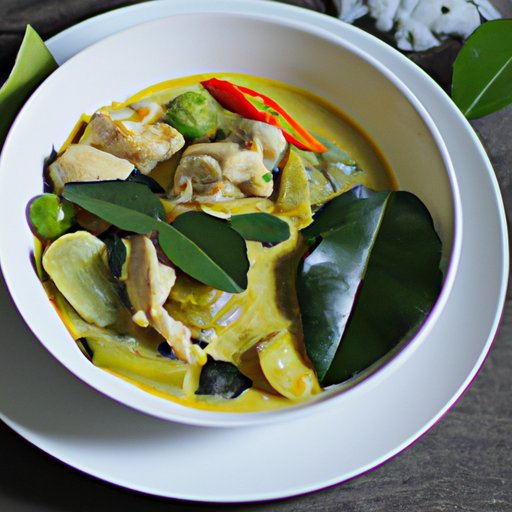Introduction
Thai green curry is a popular dish that has become widely available in many countries around the world. It features a fragrant blend of spices, herbs and vegetables cooked in a rich coconut milk-based sauce. But is it actually healthy? In this article, we’ll be exploring the nutritional analysis of Thai green curry and examining the potential health benefits and risks associated with eating this delicious dish.
Nutritional Analysis of Thai Green Curry
Thai green curry is a high-calorie dish due to its high fat content. One serving contains approximately 500 calories and 25 grams of fat. However, it is also a good source of protein, providing 15-20 grams per serving. In terms of micronutrients, Thai green curry is a good source of vitamins A and C, as well as calcium, iron and potassium.

Exploring the Health Benefits of Thai Green Curry
The health benefits of Thai green curry come from its unique blend of ingredients. The combination of coconut milk, green curry paste, herbs and spices provides a range of antioxidants, which can help protect against cell damage and inflammation. Additionally, the dish contains anti-inflammatory properties that can help reduce the risk of certain diseases such as cancer, heart disease and diabetes. Finally, the high levels of healthy fats present in Thai green curry can help improve heart health by reducing cholesterol levels and improving blood flow.

The Pros and Cons of Eating Thai Green Curry
As with any food, there are both positives and negatives associated with eating Thai green curry. On the plus side, the dish is packed full of vitamins and minerals that can benefit overall health. Additionally, the high levels of healthy fats can help improve heart health. On the other hand, the dish is high in calories and fat, so it should be enjoyed in moderation. Additionally, some of the ingredients used in traditional recipes may be difficult to find or hard to prepare.

A Guide to Making a Healthy Thai Green Curry
Making a healthy version of Thai green curry is easy if you follow these simple steps:
- Start by gathering the ingredients – coconut milk, green curry paste, fresh herbs and spices, vegetables and protein of your choice.
- Next, heat a pan over medium heat and add the green curry paste. Cook for 1-2 minutes, stirring constantly.
- Add the coconut milk and bring to a simmer. Then, add the vegetables and cook until tender.
- Finally, add the protein of your choice and cook until done. Serve with steamed rice or noodles and enjoy!
Comparing Traditional and Modern Thai Green Curry Recipes
Traditional Thai green curry recipes often call for the use of animal fat and processed ingredients, such as MSG and preservatives. These ingredients can be unhealthy if eaten in excess. On the other hand, modern recipes often focus on using healthier ingredients, such as lean proteins, fresh vegetables and natural sweeteners. Additionally, these recipes often omit the use of animal fat, which can help reduce the calorie and fat content of the dish.
Conclusion
In conclusion, Thai green curry can be a healthy option when made with the right ingredients. The dish is packed full of vitamins and minerals, as well as antioxidants and anti-inflammatory properties. Additionally, its high levels of healthy fats can benefit heart health. However, it is important to note that traditional recipes often contain unhealthy ingredients, so it is best to opt for modern recipes that focus on using fresh, natural ingredients.
(Note: Is this article not meeting your expectations? Do you have knowledge or insights to share? Unlock new opportunities and expand your reach by joining our authors team. Click Registration to join us and share your expertise with our readers.)
